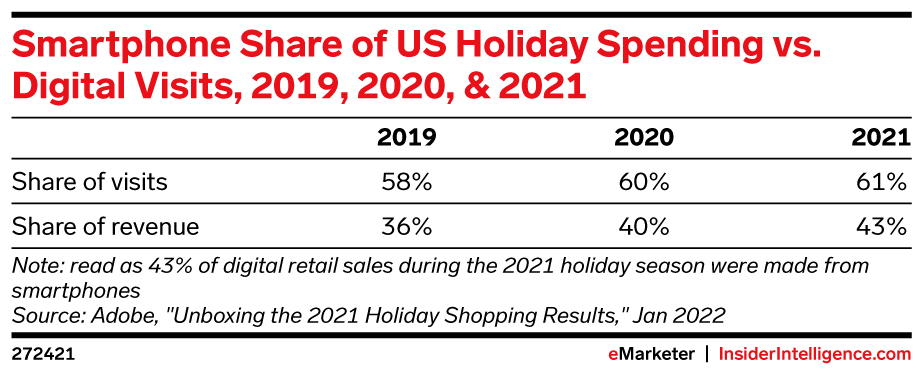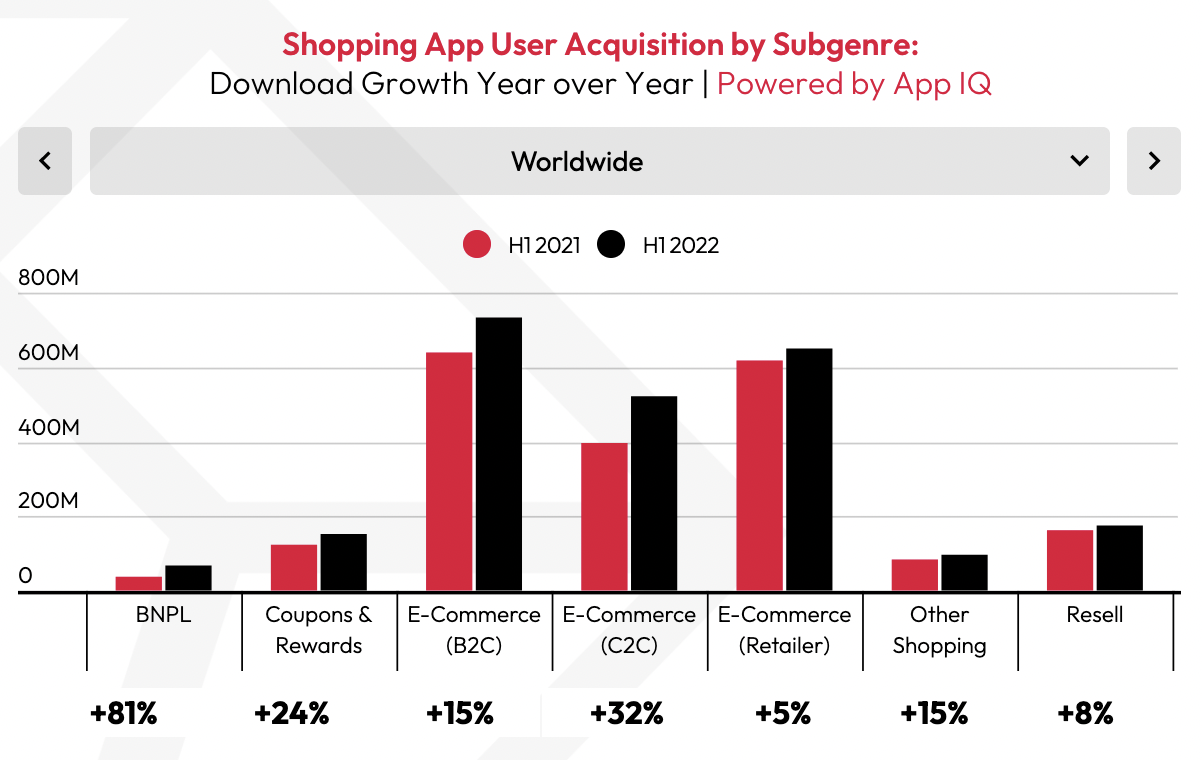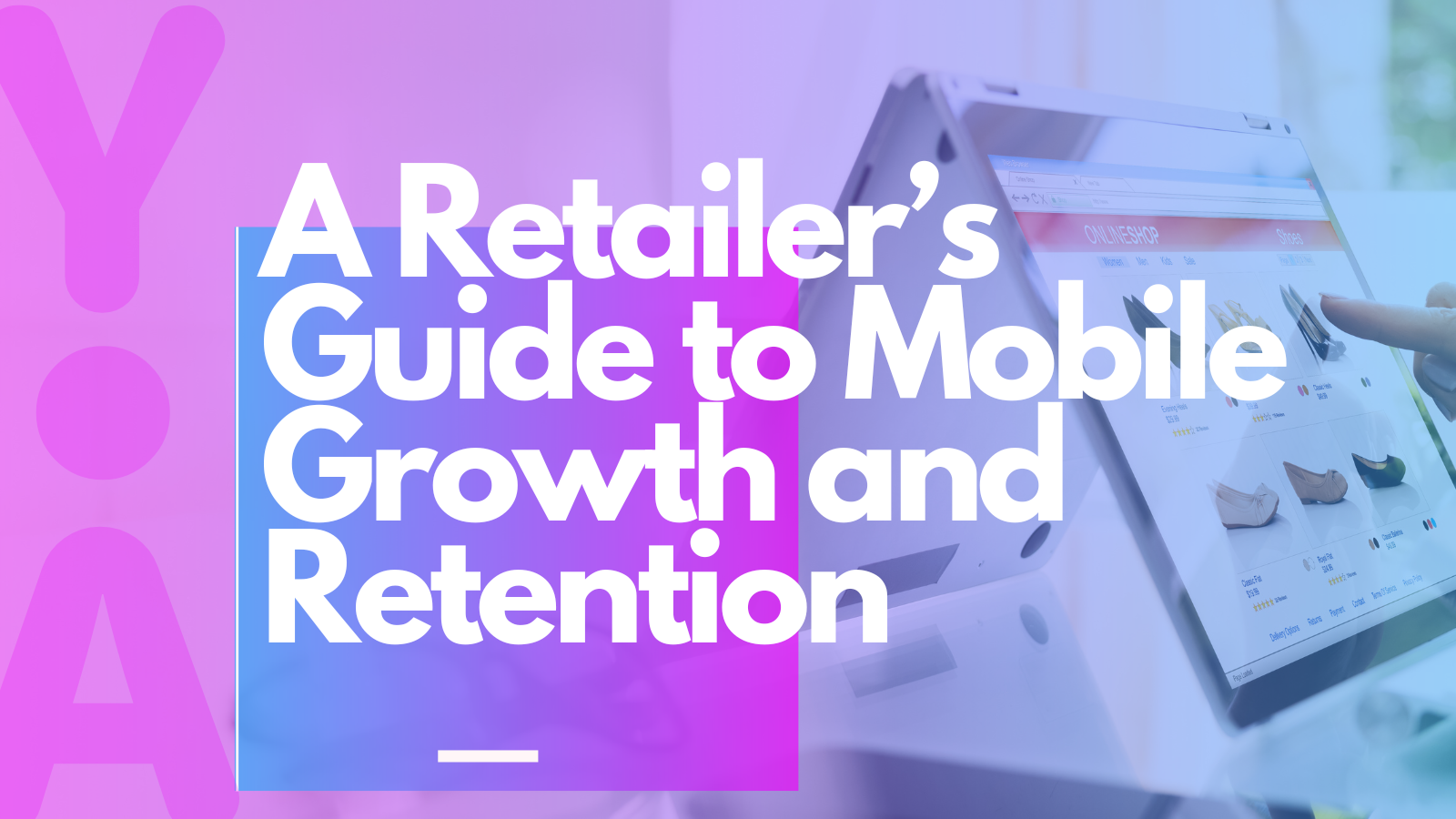With the Q4 holiday shopping season just around the corner, it’s a key time for your retail brand to be investing in mobile growth and retention. Why? Because mobile devices continue to be a key, growing sector of retail commerce. Below, find our tips for optimizing your mobile growth and retention strategy to prepare for the end of year shopping season with retail app marketing.
Why retail brands need to be investing in mobile
Every year, mobile devices continue to take up a larger and larger share of total holiday ecommerce sales. In 2021, 61% of all retail shopping visits and 43% of revenue were driven by mobile devices. Current forecasts predict the 2022 holiday shopping season will outperform these trends. In fact, mcommerce sales are projected to hit $116.98 billion, or 49.6% of overall 2022 holiday ecommerce sales. This means 2022 will likely be the last year mobile devices don’t drive a majority of holiday sales.

Source: Insider Intelligence
Apps are growing across retail segments
Another reason why retail brands should be investing in mobile retail app marketing, not just for mobile growth and retention, is because across retail categories, mobile apps are growing. According to Data.ai, the most growth to date that has been generated by retail apps has been in the Buy Now Pay Later (BNPL) sector. Apps in this category have grown 85% year-over-year since H1 2021 indicating greater demand for flexible payment solutions as the economy shifts. Top apps include postpe, Klarna and Simple Pay Later.
The second top-growing sector of retail commerce are customer-to-customer (C2C) brands which have grown 32% year-over-year. This shows affordable and sustainable shopping solutions in which customers trade with each other is a growing trend. Top apps in this category include Meesho, Shopee and Snapdeal.

Source: Data.ai
As the saying goes: “if you can’t beat them, join them”. To keep up with the competition and these benchmarks of growth, retail brands should be creating long-term strategies for mobile growth and retention.
Main motivators for mobile shopping
Before we get into our tips for how to leverage mobile as a channel of revenue, it’s important to understand the main motivators of customers who make purchases on mobile devices. It’s also important to understand why they veer away from mobile channels when deciding to shop or make a purchase. By understanding both what drives consumers towards — and away — from mobile devices, you can optimize your mobile growth and retention strategy accordingly.
Time-savings
According to research by personalization platform, Dynamic Yield, 76% of consumers shop on mobile devices because “it saves them time.” With this feedback in mind, focus on making your mobile shopping experience as cost-efficient as possible. This might include focusing on streamlining your onboarding and checkout flows. Enabling customers to save their credit card information for quick checkout when they make future purchases is a key functionality in this regard.
Convenience
While shoppers might turn to mobile channels to save time, they don’t necessarily do so when they’re looking for the most frictionless experience. Only 12% of consumers find shopping on the mobile web convenient. Furthermore, consumers are 4x more likely to say desktop is more convenient than mobile web when it comes to shopping. This shows up in the conversion data: consumers claim to complete 61% of their purchases on a desktop computer. Why don’t shoppers find mobile channels convenient? Well, one reason might be browsing functionality. Sixty-seven percent of consumers cite “pages and links being too small to click on” as an impediment to mobile shopping. Furthermore, 36% of consumers said interruptions from pop-up messages, apps and other programs intruded on their experience. Finally, 36% of customers cited having “difficulty finding what I am looking for” as a barrier to mobile shopping.
The takeaway? Tools like deep links and easily-clickable CTA buttons could be a game changer in your mobile strategy. Enhance your funnel to make items easily discoverable whether on your mobile website or in your app to aid in mobile growth and retention. Furthermore, if you monetize with advertising make sure the ads you show within retail app marketing are not intrusive to a customer’s shopping experience.
Data security
Last point — consumers are concerned about their data. And, why shouldn’t they be? With near constant digital data breaches flooding the news, shoppers are weary of having their sensitive information tampered with. When it comes to security concerns, 42% of consumers said it was the second most common reason they refrained from mobile shopping (after the complaint that “pages and links being too small to click on”). To confront these concerns, communicating clearly and transparently about how you safely collect and store your customer’s data is key.
The path to mobile growth and retention for retail brands
1. Optimize your onboarding and checkout processes
A seamless onboarding and checkout process is crucial for driving conversions in retail app marketing. The sign-up stage is the point in many retail apps’ funnels when they see significant user drop-off. To confront this, consider delaying your sign-up process until customers navigate to checkout. If this is not possible in your funnel, then make your sign-up process simpler with social media or Google login options. Minimize the number of required fields in your sign up flow and think about what information could be asked for at a later stage to increase mobile growth and retention.
When it comes to checkout, our advice is to repeat the following: “What would Amazon do?” According to Dynamic Yield, 61% of consumers say Amazon provides more streamlined checkout than their favorite online retailer. When it comes to doing it like Amazon, the fewer clicks (or, we should say, taps) to purchase the better. A multi-page checkout process will just create more opportunities for user drop off. Again, make it easy for customers to save their payment information for faster checkout.
2. Build a better loyalty program
Loyalty programs are gaining popularity in mobile because to users, they’re synonymous with discounts and mobile growth and retention. However, there are ways to optimize your loyalty program to expand beyond just deals. Use your loyalty program to understand your customers’ needs and earn their trust. This drives purchases; according to Accenture, 91% of customers are more likely to become repeat buyers after a customized experience with a brand.
Earning your customers’ trust with loyalty programs can be done by leveraging data-driven personalization to make relevant recommendations. You can also use personalization in retail app marketing to make relevant reward offerings. For example, if you notice a customer bought two of a certain product, offer them a “buy 1, get one” deal to incentivize a next purchase.
3. Reduce cart abandonment with retargeting
According to Baymard Institute, more than 69% of all transactions are abandoned. This research points to the fact that shopping cart abandonment might be the most pressing challenge retail brands face today.
There are many ways to confront the issue of cart abandonment and encourage mobile growth and retention. One of them is a robust push notification strategy. Another is combining your brand marketing with robust performance marketing initiatives like retargeting campaigns.
You can segment and re-engage users with retargeted ads that entice them to come back with discounts. You can also serve ads that create a sense of urgency. This might be by including ad text like “limited-time” or “only a few of these items left” to get them to come back to their abandoned cart.
Finally, get personal with your retail app marketing strategy. Use dynamic creative optimization to serve ads showing items they’ve left in their shopping cart or similar items to past purchases they’ve made. Time these ads to appear during times of the day or season that they’re most likely to make purchases during.
Takeaways
With the Q4 holiday shopping season just around the corner, it’s a key time for your retail brand to be investing in mobile growth and retention. With almost half of 2022 holiday ecommerce sales projected to be generated by mobile devices, mobile is a key channel for retail marketers.
- Optimize your onboarding and checkout processes. Minimize the number of required fields in your sign up flow and think about what information could be asked for at a later stage. Make payment information saveable for faster checkout.
- Build a better loyalty program. Don’t just offer deals and discounts as part of your loyalty program. Build customers’ trust by using data-driven personalization to offer relevant products and rewards.
- Reduce cart abandonment with retargeting. Combine your brand marketing with performance marketing initiatives like retargeting to reduce the 69% of transactions that consumers abandon before completing their purchase, and encourage mobile growth and retention.
Looking to enhance your mobile retail growth and retention?
With inflation-strapped customers slowing their buying in today’s economic headwinds, it’s critical to add retargeting to your brand marketing activities. Whether you’re looking to learn more or launch a campaign asap, we’re here to help. Reach out to us to explore how retargeting can help you and retail brand’s bottom line this Q4.

